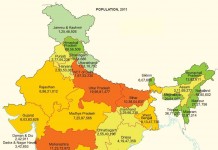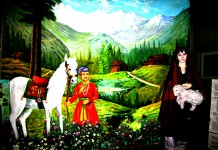Bibi Taj Khatun:
Taj Khatun was the daughter of Sayyid Hasan Bahadur, the commander of Sultan Shihab-ud-Din’s forces. Sayyid Hasan belonged to a very distinguished family and was the son of Sayyid Taj-ud-Din Hamadani. It will be recalled that Shah Hamadan brought about reconciliation between the Kashmir and Ohind armies. It was on this occasion that, according to one of the terms of the treaty, two girls of the royal family of Ohind were married to two Kashmir notables. Bibi Taj Khatun was the daughter of Sayyid Hassan from this marriage. Special pains were taken in the matter of her education. She was married to Mir Muhammad Hamadani, the son of Shah Hamadan. Bibi Taj Khatun was of a saintly character. She passed most of her time in meditation in the garden built for her, near which Fath Kadal was subsequently built. She was buried in the same garden.
Bibi Bari’a:
Bari’a was the daughter of Malik Saif-ud-Din, for forty years the Chief Minister of Kashmir and, after her conversion with her father, was married to Mir Muhammad Hamadani, after the death of Bibi Taj Khatun.
Bibi Haura:
Haura, as given in persian historie of Kashmir and called by Firishta Sura, may have really been Huriah, a houri or a nymph, was the mother of Sultan Sikandar and the queen of Sultan Qutb-ud-Din. She was a remarkable woman, an exercised tremendous influence over her husband and subsquently over Sultan Sikandar. It was her wrong personality that kept down all mischief during the earlier part of the reign of her son. She was gifted with a strong mind and could strike terror into the hearts of enemies. She practically acted as the regent of her son for some time. When she found that her own daughter and son-in-law were plotting against the person of Sikandar, she did not hesitate to get them disposed of without any delay and thus nipped in the bud an evil which might have subverted the royal line of Shah Mir. Despite her prominent part in the civil and military affairs of the kingdom, she found time for devotion and was the disciple of Shah Hamadan. She was buried in the first royal burial-grond which still exists near the Kanil Masjid, Zaina Kadal, at Srinagar.
Bibi Bahat:
Bahat (meaning “Pure”) lived in the time of Bad Shah and was noted for her learning. Her sayings in Persian are still on the lips of educated Kashmiris. One of her sayings is:
He, who is relieved of the thought of existence, is relieved of anxiety and is relieved of the sorrows and fears of hope.
Bahat was the disciple of Shaikh Nur-u-Din, the Patron-Saint of Kashmir. The graves of this learned lady and that of her sister, Dahat, both being known as Chat-dedi (Chat meaning disciples in reference to the same spiritual guide) can be seen in Zalusa (or Zalus) village, in the Nagam pargana, 1.50 miles below Chrar on the motor road.
Lachhma Khatun:
Lachhma was the daughter of Malik Saif-ud-Din Dar, a military commander, during the reign of Bad Shah and Hasan Shah. She was married to Malik Jalal-ud-Din, a minister of Bad Shah. Lachhma was well-known for her learning and piety and founded a Khanqah (hospice) and a madrasa near the Jami Masjid in Mahalla Gojwara. The madrasa has disappeared, but the Khanqah, now a Ziyarat, still exists there and is known as Masjid-i-Qazi’on account of the Qazis of Srinagar issuing their fatawa, or rulings, from a place near about. For the Jamia masjid specially, as also for her Khanqah and madrasa, she brought a waterway right from Lar. It was called the Lachhma Kol. Kol in kashmiri means a waterway. She profited by the company of Baba Isma’il Kubravi, who was the Shaikh-ul-Islam of Sultan Hasan Shah and became the Shaikh’s murid or disciple.
Gul Khatun:
Gul Khatun, the queen of Sultan Haider Shah, built a madrasa. She was also famed for her solicitude for Hindus. Crivara says of her that ‘she favoured the customs of Hindus as the light of the sun favours the lotus.’ She was greatly esteemed by all and men wept at her death.
Bibi Saliha:
Saliha was the queen of Sultan Muhammad Shah and the sister of Kaji Chak. She also came under the influence of Bab Isma’il Kubravi. Kashmiris remember her for the reconstruction of the Shrine of Shah Hamadan, known as the Khanqah-i-Mu’alla, which had been demolished by the Shi’as. She would not touch state revenues and therefore sold her jewellery to defray those expenses.
Hafiza Maryam:
The roll of famous women of Kashmir claims the tutoress of the celebrated Zib-un-Nisa Begam, the daughter of Aurangzib Alamgir. Hafiza Maryam, to whom Zib-un-Nisa owed her education, was a learned lady, wife of Mirza Shukrullah of Kashmir. Maryam’s scholarly son, Inayatullah Khan, rose to the position of Mughal governor of Kashmir. She died on the 26th of Rabi’-u-Sani 1089AH(1678AC).
Reference:
Sufi,G.M.D (1996). Kashmir Under The Mughals. Kashir: Being A History Of Kashmir(pp.427-429) Delhi:Capital Publishing House.

















